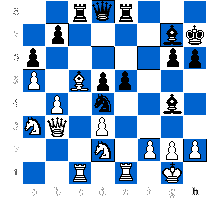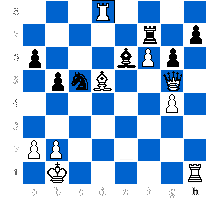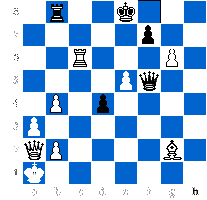POSITIONS OF THE CANDIDATES FOR USCF ELECTION
by Anonymous
The National Open in Las Vegas, held April 26-28, 1996, was attended by a majority of the candidates for the coming elections of the United States Chess Federation. The reason was obvious. The New York Open, held three weeks earlier, had been contested by grandmasters and other strong and prestigious players, but almost none of them have the right to vote in USCF elections. As a result, the New York Open had been ignored by all but two of the candidates, and one of those two had been employed as a director there. However, at the National Open in Las Vegas, there were votes to be had. As a result, only four of the candidates completely ignored this event.
Most of the candidates are extremely cagey when is comes to revealing their actual positions on serious issues. As one commentator has noted, most of the candidates in their electioneering only set forth "feel good" positions with which everybody will agree, such as "Let's rook more of our children into playing chess". Rarely does a candidate take a concrete position on a contentious issue such as "Let's sell the USCF building and spend all the money right away", with which there is substantial likelihood of disagreement outside of those who would control the money.
However, the format of the National Open was such that most of the candidates had no real choice but to provide actual positions. The exception to this was Rachel Lieberman, a candidate for USCF Secretary, who openly admits that she will never be the world's strongest chess player, and therefore does not make any pretense in that area. Rachel simply watched the event.
As to the rest of the candidates, they found themselves in a situation where they had no real choice but to set forth clearly definable and concrete positions. Here are some of those positions:
POSITION OF BOB HOLLIMAN, CANDIDATE FOR VICE-PRESIDENT OF THE USCF
In Las Vegas, Bob Holliman, candidate for election as Vice-President of the USCF, met with a mysterious former Soviet KGB operative code-named "Goofy". This "Goofy" and Holliman were found to be in the following compromising position:
Holliman - "Goofy" , Las Vegas, 1996 - White to move
Diagram 1
SECRET KGB AGENT/BLACK

BOB HOLLIMAN/WHITE
Position after 29. f4
Las Vegas, 1996 - Due to some vile conspriacy, White resigned. This resignation was obviously some sort of code, a signal to his KGB handlers in Moscow, as there is nothing wrong with White's position.
|
In this position, obviously due to some vile conspiracy, White resigned. Why did White resign? Beats me! It is true that White has a lousy position. One wonders how Bob Holliman ever got his USCF master's rating of 2203 with him playing like he has up until this point. Nevertheless, nobody resigns in a position like this. After 21. Bxd4 exd4 22. Nf1, White seems to be holding, at least for a while. The House Un-American Activities Committee really should investigate this.
POSITION OF TOM DORSCH, CANDIDATE FOR TREASURER OF THE USCF
Next, we have the position of Tom Dorsch, candidate for USCF Treasurer. The treasurer holds the money, so we need to see how Tom holds his. Here's how:
Diagram 2
TOM DORSCH/BLACK

ULRIC AERIA/WHITE
Position after 20. ..... Nd4
Aeria - Dorsch, Las Vegas, 1996 - Black to Move. Tom gave up. White threatens 30. f5+ followed by 31. Qg3# checkmate. If 29. ... e3 30. f5+ Ke5 31. Qg3+ Ke4 32. Qf4# checkmate. The only way for Black to stop immediate mate is either 29. ... Rag8 or 29. ... Rhg8 and Black must give up both rooks for just one knight to stop checkmate.
|
I know exactly what all of you are thinking. I cannot at all blame you for thinking this, but honestly it isn't true. I am not showing these particular positions just to embarrass the candidates. These just so happen to be the only positions of the candidates which I have, because these are the only positions which were published in the only issue of the official tournament bulletins which I happen to possess. All of these positions are taken from the bulletin issued for the day of April 27, 1996.
The nameless bulletin editor (as least no name is provided in the bulletin) states: "The result of this conflict is my favorite game of the tourney thus far." Obviously, who ever wrote this is not planning to vote for Tom, because a more horrible fate could no man imagine in his worst nightmare. The bulletin editor states: "Now, this is real he-man's chess, but I bet it wasn't much fun for Dorsch. Even though salivating with the taste of several pieces, he could never be sure which meal was to be his last!"
So, Tom gave up. This time, there is no mystery about it. White threatens 30. f5+ followed by 31. Qg3# checkmate. If 29. ... e3 30. f5+ Ke5 31. Qg3+ Ke4 32. Qf4# checkmate. The only way for Black to stop immediate mate is either 29. ... Rag8 or 29. ... Rhg8 and Black must give up both rooks for just one knight to stop checkmate.
Just so that nobody feels that I am treating Tom unfairly by showing this position, here is the other of his positions to be found in this tournament bulletin.
In order to achieve this position, Tom played the Moron Gambit. Tom picked exactly the right opponent to play it against. Tom's opponent was rated 1100 and was by far the lowest rated player in the tournament. His rating was also less than 50% of Tom's rating. He proceeded to demonstrate fully the reason for his rating.
Is well known that castling queenside is the one thing that Black must not do against the Moron Gambit (so-named because White gives away a pawn for absolutely nothing at all). Nevertheless, Black did that anyway, and look at the result:
Dorsch - Vest, Las Vegas, 1996 - Black to Move
Diagram 3
ELVIS VEST/BLACK

TOM DORSCH/WHITE
Position after 20. Rb1+
Dorsch - Vest, Las Vegas, 1996 - Black to Move. Elvis no doubt felt uneasy and insecure about a certain weakness in his king's situation and, noting that his opponent was rated more twice that he, decided to give up.
|
Here, Black no doubt felt uneasy and insecure about a certain weakness in his king's situation and, noting that his opponent was rated more twice that he, decided to give up.
POSITION OF JIM EADE, CANDIDATE FOR POLICY BOARD MEMBER-AT-LARGE OF THE USCF
Jim Eade came to the National Open just for the purpose of politicking, with no intention whatever of playing in the tournament. However, after three rounds of trying to talk politics, while almost everybody else was playing chess, Eade apparently became stir-crazy and finally decided to enter the tournament, three rounds late. Then, on top of that, Eade lost his first actually played game to a much lower rated player. As the bulletin editor noted, "Life isn't easy this tournament for those running for elected office within the USCF ... the majority have lost."
This time, as Eade played a theoretical game (and did not play like a moron), some comments about his opening are appropriate. The game followed a standard line of the French Defense played by Timman and others. However, on move 11, Black usually plays either Bxd4 or Nxd4 followed by 12. ... b5. Black has had good results with this. Instead, Eade played the more passive 11. ... Qc7. White's 12. g4 seems to be an improvement over the 12. h4 which has been played in other games. White quickly obtained the following overwhelming position:
Roper - Eade, Las Vegas, 1996 - White to move
Diagram 4
JIM EADE/BLACK

DAVID ROPER/WHITE
Position after 26. ....... Be6
Roper - Eade, Las Vegas, 1996 - White to Move. Other than having a lost position, I cannot see why Eade resigned, but he did.
|
Actually, other than having a lost position, I cannot see why Eade resigned, but he did. Another player would have played on for a few more moves.
POSITION OF DON SCHULTZ, CANDIDATE FOR PRESIDENT OF THE USCF
Don Schultz had no position.
That's right. Unlike every other candidate playing in the tournament, Don Schultz had no position published in the tournament bulletins. Probably the real reason for this was that the positions of Don Schultz were unpublishable. Don at this point was at the bottom of the tournament, having lost every game that he had played.
POSITION OF SAM SLOAN, CANDIDATE FOR PRESIDENT OF THE USCF
Years ago, there was a 2350 played named Weaver W. Adams who wrote a book called "White to Play and Win". His thesis, as expounded in this and other books by Adams, was that White has a winning position on the very first move. He intended to prove this absolutely. Adams would often publish collections of his games, all wins by Adams, and of them he would say: "There are no annotations, because every move is crystal clear."
And, just as there, here in the game of Sam Sloan we can see that elegance of style, that crystal clear inspiring, lets see now, that awesome display of clear thematic strategic principles, open lines and simple but forceful moves.
Weaver W. Adams had the right idea, but the only thing he got slightly wrong what that White does not win with 1. e4 as he said, but rather with a move two squares to the right.
So, anyway, Sloan got to this position against an opponent rated 2172 (who, incidentally, is a frequent contributor to the Internet).
Sloan - Stein, Las Vegas, 1996 - Black to Move
Diagram 5
PETER STEIN/BLACK

SAM SLOAN/WHITE
Position after 46. Ka1
Sloan - Stein, Las Vegas, 1996 - Black to Move. White has a thematic, logical position. His king is safely in the corner, shielded by his queen, and his queen and bishop cut off all harassing checks, so the exposure of his opponent's king wins the game. Black resigns.
|
As you can see, White has a thematic, logical position. His king is safely in the corner, shielded by his queen, and his queen and bishop cut off all harassing checks, so the exposure of his opponent's king wins the game. Black resigns.
Now, here are the games in full.
[Event "National Open"]
[Site "Las Vegas (USA)"]
[Date "1996.04.27"]
[Round "4"]
[White "Holliman Bob"]
[Black "Gufeld Eduard"]
[Result "0-1"]
[ECO "B31"]
1. e4 c5 2. Nf3 Nc6 3. Bb5 g6 4. O-O Bg7 5. Re1 e5 6. c3 Nge7 7. a4 O-O
8. Na3 d6 9. d3 h6 10. Rb1 f5 11. exf5 Bxf5 12. Be3 a6 13. Bxc6 Nxc6
14. b4 cxb4 15. cxb4 Kh7 16. Qb3 d5 17. Bc5 Re8 18. a5 Rc8 19. Rbc1 Bg4
20. Nd2 Nd4 0-1
[Event "National Open"]
[Site "Las Vegas (USA)"]
[Date "1996.04.27"]
[Round "4"]
[White "Aeria Ulric E"]
[Black "Dorsch Tom"]
[Result "1-0"]
[ECO "E70"]
1. c4 Nf6 2. Nc3 g6 3. e4 Bg7 4. d4 O-O 5. Nf3 a6 6. Be2 c5 7. d5 b5
8. e5 Ng4 9. Bf4 f6 10. O-O fxe5 11. d6 e6 12. Bg5 Qb6 13. Be7 Re8
14. Nd5 exd5 15. Qxd5+ Kh8 16. Ng5 h6 17. Nf7+ Kh7 18. Bxg4 Bb7 19. Qd3
e4 20. Qh3 Nc6 21. Nxh6 Nxe7 22. Nf5+ Kg8 23. Nxe7+ Kf7 24. Rad1 Rh8
25. Qg3 Bf6 26. Be6+ Kxe6 27. Qg4+ Kf7 28. Qxg6+ Ke6 29. f4 1-0
[Event "National Open"]
[Site "Las Vegas (USA)"]
[Date "1996.04.27"]
[Round "3"]
[White "Dorsch Tom"]
[Black "Vest Elvis C"]
[Result "1-0"]
[ECO "B21"]
1. e4 c5 2. d4 cxd4 3. c3 dxc3 4. Nxc3 Nc6 5. Nf3 d6 6. Bc4 e6 7. O-O
Be7 8. Qe2 Bd7 9. Rd1 Qc7 10. Bf4 O-O-O 11. Rac1 a6 12. b4 Nxb4 13. Qb2
Nc6 14. Nd5 exd5 15. exd5 Bf6 16. Qa3 Ne5 17. Bxa6 Nxf3+ 18. gxf3 bxa6
19. Qxa6+ Kb8 20. Rb1+ 1-0
[Event "National Open"]
[Site "Las Vegas (USA)"]
[Date "1996.04.27"]
[Round "4"]
[White "Roper David C"]
[Black "Eade James"]
[Result "1-0"]
[ECO "C11"]
1. e4 e6 2. d4 d5 3. Nc3 Nf6 4. e5 Nfd7 5. f4 c5 6. Nf3 Nc6 7. Be3 a6
8. Qd2 cxd4 9. Nxd4 Bc5 10. O-O-O O-O 11. Kb1 Qc7 12. g4 b5 13. Nxc6
Qxc6 14. Bxc5 Nxc5 15. Bg2 Qc7 16. f5 Qxe5 17. Rde1 Qd6 18. f6 Rd8
19. Qg5 g6 20. h4 Ra7 21. h5 Qf8 22. hxg6 fxg6 23. Nxd5 exd5 24. Re7 Qf7
25. Rxf7 Rxf7 26. Bxd5 Be6 1-0
[Event "National Open"]
[Site "Las Vegas (USA)"]
[Date "1996.04.27"]
[Round "3"]
[White "Sloan Sam"]
[Black "Stein Peter"]
[Result "1-0"]
[ECO "A00"]
1. g4 d5 2. Bg2 c6 3. h3 e5 4. e4 d4 5. d3 Be6 6. Ne2 g5 7. Ng3 Nd7
8. Nf5 Qf6 9. Nd2 Bb4 10. a3 Bxd2+ 11. Qxd2 Bxf5 12. exf5 h6 13. Qa5 Qd6
14. h4 gxh4 15. Rxh4 Qf6 16. Rh5 Qg7 17. f3 Ngf6 18. Rh2 Nd5 19. Bd2 h5
20. O-O-O hxg4 21. Rxh8+ Qxh8 22. Rh1 Qg8 23. fxg4 N7b6 24. g5 O-O-O
25. Qxa7 Kc7 26. Qa5 Ra8 27. Qc5 Nd7 28. Qc4 b5 29. Qb3 Nc5 30. Qa2 Nb6
31. Rh6 e4 32. dxe4 b4 33. e5 b3 34. Rxc6+ Kd7 35. cxb3 Rc8 36. Rd6+ Ke8
37. Rxb6 Ne4+ 38. Kd1 Nxd2 39. Rc6 Rb8 40. g6 Qh8 41. b4 Qh5+ 42. Kxd2
Qg5+ 43. Kd1 Qg4+ 44. Kc1 Qf4+ 45. Kb1 Qxf5+ 46. Ka1 1-0
Here is a link to more information about the election: The Candidate's Statements
Contact address - please send e-mail to the following address: Sloan@ishipress.com 



